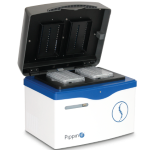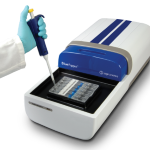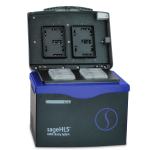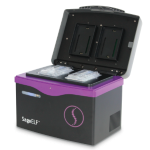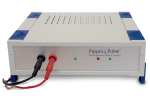Nanopore Sequencers Give Optimal Results with BluePippin Size Selection
The Oxford Nanopore team has been speaking recently about their use of our BluePippin automated size selection system for optimizing the read length obtained from nanopore sequencers. For anyone interested in the Oxford platforms who hasn’t seen this information, here’s a quick recap.
As we’ve seen with PacBio, the other long-read platform, single-molecule sequencers tend to produce reads as long as the fragments fed to them. Naturally, users interested in maximizing the read lengths of these systems want to feed them only the longest possible fragments. The simplest and most effective way to do that is what we call high-pass sizing, or selecting all DNA fragments longer than a certain size threshold during the sample prep process.
For the MinIon and PromethIon sequencers from Oxford Nanopore, the company recommends BluePippin sizing for various protocols. This library prep workflow for both sequencing systems uses BluePippin to eliminate shorter fragments; one example of outcomes shows a whopping 255 Kb read from an E. coli experiment. There’s a similar rationale for recommending BluePippin for de novo whole genome assembly with the MinIon system. And this protocol demonstrates how automated sizing fits into a sequence-capture approach for library prep prior to nanopore sequencing.
We’re delighted that BluePippin is showing such utility for nanopore sequencing. If you’re an Oxford Nanopore customer who doesn’t already have access to one of these instruments, contact us to learn how BluePippin can make a difference in your pipeline.
ASHG 2016: Structural Variants, Mega Databases, and the Best-Ever Human Genome
The Sage Science team enjoyed our trip across the border to Canada for the annual meeting of the American Society of Human Genetics this month. Vancouver was practically teeming with genome scientists!
Many presentations this year featured results generated by mining the slew of publicly accessible sequence databases that have come online in recent years, with plenty of exciting new correlations between genetic conditions and markers. Cancer was a commonly studied disease, with new associations that could really pay off for patients down the line if they can be validated for clinical utility.
We also saw that these databases are growing quickly. The Broad Institute announced a new version of the ExAC database, called gnomAD, which essentially doubles the number of exomes and genomes from which it catalogs genetic variants. The conjunction of these massive genomic resources with big data analysis tools stands to revolutionize the speed at which discovery moves in human genetics.
In recent years, we’ve seen that ASHG presenters are going beyond SNPs to interrogate large variants, and this year continued the trend. Structural variants got more airtime than ever, with technologies such as PacBio, BioNano Genomics, 10x, and more making it easier for researchers to access this complex information. We’re encouraged that the community is embracing these tools to analyze extremely large fragments of DNA in order to uncover entirely new genetic mechanisms that could contribute significantly to disease.
A real highlight of the meeting was Macrogen’s presentation of the recently published Korean reference genome, which used PacBio, BioNano, and other technologies to create the most complete human assembly ever. Several whole chromosome arms were assembled into individual contigs, a stunning feat. The team also reminded ASHG attendees that two-thirds of the world’s population is of Asian descent, underscoring the need to invest in more genome resources for Asian individuals.
Many thanks to all the attendees who took time out of a busy conference to stop by our booth and chat with the Sage team. We were honored by all the attention that our new SageHLS instrument got in its first outing, and look forward to seeing how it enables better science when it hits lab benches soon.
Get a Glimpse of the New HLS Instrument at ASHG 2016
The Sage Science team is heading to Vancouver this week for the annual meeting of the American Society of Human Genetics. ASHG is the biggest genomics meeting we attend each year, and it never fails to deliver on its promise of top-notch science and compelling speakers.
We’re especially enthusiastic about this meeting because it’ll be the first time we show off our newest instrument, the HLS platform, in booth #732. Though this is just a sneak peek as development continues, we anticipate launching the instrument soon and thought ASHG attendees would enjoy getting a glimpse.
The HLS platform (short for HMW Library System) will allow scientists to purify ultra high molecular weight DNA directly from cells for the increasing number of applications that require it, such as long-read sequencing or long-range genomics. Working with large DNA fragments has become a lost art in the era of short-read sequencing. But with the rise of PacBio and Oxford Nanopore sequencers, 10x Genomics synthetic long reads, and optical maps from BioNano Genomics and other providers, it’s clear that users need a solution for handling DNA that’s hundreds of kilobases or even megabases long.
We built the HLS instrument to address this need. At launch, it will be able to purify DNA from about 50 Kb to 2 Mb in length, directly from blood samples, cell lines, or bacterial cultures. In our hands, the elutions yield more than a microgram — plenty of DNA for de novo genome sequencing, droplet digital PCR, and other long-range genomics applications. Initially, users will perform purification on the HLS instrument followed by traditional library prep, but in the future we aim to incorporate library prep directly into the system. We’re also already working on targeted genomic fragment extraction using CRISPR/Cas9 as a later-stage application for the HLS instrument.
To learn more about how the system works, check out this blog post or poster. If you’ll be at ASHG, we hope you stop by the booth to check it out!
At the University of Florida, SageELF Delivers Better Sizing for ddRAD-seq and Long-Read Pipelines
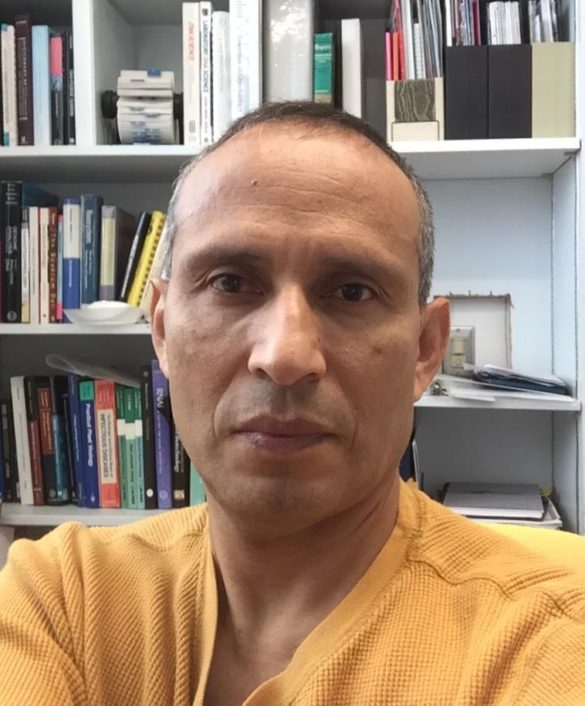 Clients of the NextGen DNA Sequencing core at the University of Florida in Gainesville rely on Scientific Director David Moraga Amador to find and validate the best technologies for their projects. In addition to bringing in the best sequencers, that means hunting for sample prep methods and instruments that make downstream results more reliable and reproducible.
Clients of the NextGen DNA Sequencing core at the University of Florida in Gainesville rely on Scientific Director David Moraga Amador to find and validate the best technologies for their projects. In addition to bringing in the best sequencers, that means hunting for sample prep methods and instruments that make downstream results more reliable and reproducible.
For scientists using a custom ddRAD-seq protocol with Illumina sequencing, the core lab team recommended SageELF, which performs whole-sample fractionation and splits input DNA by size into 12 contiguous fractions. These clients had been coming to the lab with libraries that were challenging to sequence cleanly because of their wide size distribution. “These libraries often look very ugly: they have a broad range size distribution, multiple peaks, and they’re very difficult to quantitate,” Moraga Amador says. “Fragments might go from hundreds of base pairs to ten thousand base pairs.” To address the problem, the team began running these libraries on the SageELF and delivering fractions back to users with a TapeStation analysis of fragment size; the clients then choose which to advance to sequencing. “Our users love the fact that these peaks are so sharp, the sequencing output is predictable, and the quality metrics are improved,” he says. “Now we have five or six groups doing this routinely.”
Years before that, Moraga Amador had become a Sage Science customer when he introduced the PacBio sequencing platform to his core lab and brought in a BluePippin to increase average read lengths. When the SageELF launched more recently, he saw an opportunity to maintain the precise size selection he was used to while making more of each sample.
With BluePippin, Moraga Amador and his team used the high-pass protocol for long-read sequencing (PacBio RS II), collecting all fragments longer than a certain size. The smaller fragments were tossed out as part of the size selection process. With SageELF, he can use the whole sample, allocating each fraction to the part of the project where it will have the most value. “All of those fractions are good,” Moraga Amador says. “They turn into very sharp fractions and they sequence beautifully on the instrument.” SageELF lets his team size DNA up to 30 Kb, fitting nicely with the requirements for the PacBio instrument.
Moraga Amador says the device is also useful for PacBio Iso-Seq projects, where protocols require binning DNA by size prior to sequencing. “With the SageELF we just do one single run and collect all the fragments for our samples, and then pool the fragments of like size,” he says. “The key for us is doing a single run so we don’t waste any of the sample.” SageELF allows his team to generate the needed fractions from much less sample DNA than if they had to size each fraction individually.
The SageELF system was easy to set up and start running, Moraga Amador notes. “It didn’t take a lot of practice,” he says, noting that the team set up the instrument themselves with a little phone support from Sage Science. For most projects, there’s no tinkering required to get the results they expect. “There is very little optimization we have to do if we follow the instrument recommendations,” he adds.
Poster: Better Cell-Free DNA Analysis with Pippin + Rubicon Genomics
Recently we blogged about the rise of cell-free DNA studies, and how precise size selection is one tool that can help researchers isolate DNA of interest for further analysis (such as sorting out fetal from maternal genetic material).
At the AGBT Precision Health meeting in Scottsdale, Ariz., last month, we teamed up with Rubicon Genomics to present a poster demonstrating how our technologies can be used together to generate better results from cell-free DNA studies. (If you were at the meeting, it was poster #107.)
For this work, we performed pre-library size selection using the Pippin Prep to separate fragments 160 bp and larger (since that’s about the size of the mononucleosomal unit) from smaller fragments, which are typically the ones scientists want to analyze for cancer or prenatal studies. After sizing, we prepared libraries for sequencing using Rubicon Genomics’ ThruPLEX® Plasma-Seq kit, which is designed for low-input samples from plasma and liquid biopsies like cfDNA. Libraries were also prepared and analyzed without size selection so we could see how much of a difference that step made.
Even though we started with less than 1 ng of size-selected material, we were able to produce highly diverse libraries that were significantly enriched for cell-free DNA fragments between 60 bp and 120 bp. That enrichment did not happen for libraries prepared without size selection. This graph of insert size distribution shows how clearly delineated the shorter fragments were when size selection was used.
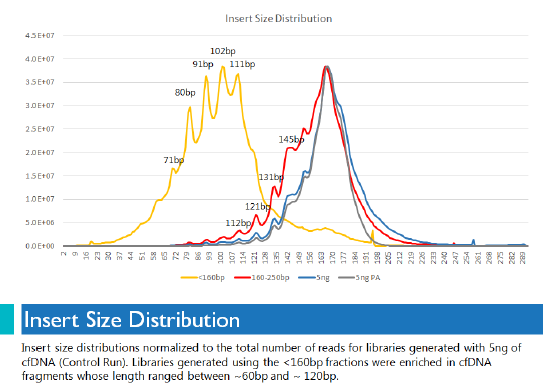
While Pippin Prep was used for this project, Sage customers can use PippinHT as well to perform what we call “low-pass” sizing — that is, removing everything larger than a certain size. We look forward to seeing how our users deploy automated size selection technology to enhance their cell-free DNA studies.
